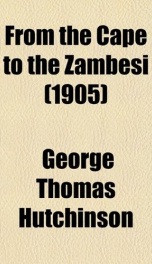from the cape to the zambesi

Purchase of this book includes free trial access to www.million-books.com where you can read more than a million books for free. This is an OCR edition with typos. Excerpt from book: CHAPTER III KIMBERLEY IT must be almost impossible for those who travel by the Cape Government Railways to realise how much they have to be thankful for. Thirty years ago the journey to Kimberley had to be made in the stage coach, and most of those who have had that experience declare that, of all the vicissitudes of the early days, this is the one most clearly impressed in their memory. Further north some of these coaches still survivepicturesque objects of American design, built to withstand all the difficulties and dangers of a road which scarcely deserves the name. They are drawn by five span of mulesand the mule can never be an ideal trapperso that two drivers are necessary, one to guide this rather difficult team in the right direction, the other to urge it into a reasonable paceSOUTH AFRICAN RAILWAYS 27 with a huge two-handed whip, and from time to time to repair damages to the harness. A week spent among these conditions, with its unending monotony, is sufficient to try the nerves of the hardiest pioneer. In England there still lingers some of the romance of ' The Road,' but in Africa it has never existed. "Nous avons changt tout cela": the old red coach has given place to the train-de-luxe, which brings Bulawayo within a three days' journey of Capetown. At the hands of those accustomed to the comforts of the Great Western or the Midland, the South African railways are perhaps open to criticism, but if the different conditions are taken into consideration, they are beyond all praise. The line is a single one, the gauge only 3 ft 6 ins.; the gradients are steep and curves abrupt; the goods traffic is practically all in one direction, and these causes combine to keep the speed lowindeed, the average is something between ten and twenty miles in the hour. But thi...
Info about the book
Author:
Series:
Unknown
ISBN:
0879820160
Rating:
3/5 (3)Your rating:
0/5
Languge:
English
Users who have this book
Users who want this book
What readers are saying
What do you think? Write your own comment on this book!
write a commentGenre
if you like from the cape to the zambesi try:
Other books by this author
Do you want to exchange books? It’s EASY!
Get registered and find other users who want to give their favourite books to good hands!


